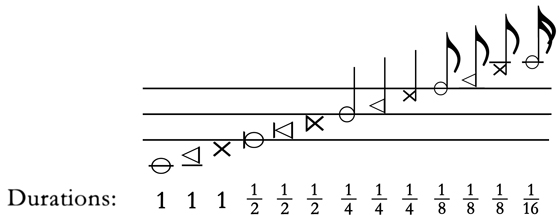

Trilinear music notation has staff lines spaced a minor 3rd apart, with two notes positioned in the spaces between the lines. In order to make the staff compact enough to be practical for reading and writing, it uses three different note heads, an ‘X’ sign, an ‘O’ sign and a triangular ‘<‘ sign. These three symbols align with their position on the staff and correspond to the three diminished 7th chords. (There are three diminished 7th chords, with four notes each, which covers all twelve notes of the chromatic scale.)
The note head symbols are designed to be easy to write down quickly and legibly, even when the staff is small. For example, even if the symbols are not written down precisely in the right positions, one could still infer which notes are intended.
The ‘basic’ system (shown above) is designed to appeal to those familiar with standard notation — by roughly preserving the positions of notes, relative to the ledger line, on the traditional treble clef staff. For example, the lowest staff line represents the note E.
A second “Tri-Chromatic” version of the system (shown below) uses the same sequence of three symbols, but shifts their position so they are better aligned with Roy Pertchik’s “Tri-Chromatic” keyboard layout and its black, white (or silver), and red color system. In this version of Trilinear notation hollow ‘O’ note heads represent Pertchik’s white notes. Non-hollow ‘X’ note heads represent his black notes. The triangular ‘<’ note heads fall on the staff lines and the lines are colored red to represent the red notes. (But see criterion 7.)

Duration symbols (in both versions) are similar to traditional notation. The difference is that half notes are indicated by a short vertical line that is drawn on the opposite side of the note head from where the stem conventionally appears. Here is an image which shows the basic duration symbols.

First Introduced: January 2017
Source: José A. Sotorrio
Similar Notation Systems: Hass, Dolmatov, Bilinear (also by Sotorrio)



